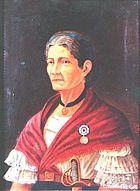| Part of a series on |
| Women in society |
|---|
 |
The following is a list of women in war and their exploits from about 1800 up to about 1899.
Contents
For women in warfare in the United States at this time, please see Timeline of women in war in the United States, pre-1945 .
Only women active in direct warfare, such as warriors, spies, and women who actively led armies are included in this list.















